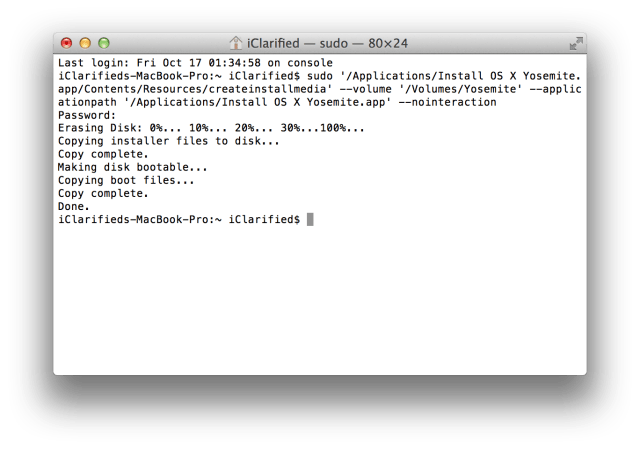

- #MAKE A BOOTABLE USB FOR OS X YOSEMITE HOW TO#
- #MAKE A BOOTABLE USB FOR OS X YOSEMITE INSTALL#
- #MAKE A BOOTABLE USB FOR OS X YOSEMITE PORTABLE#
- #MAKE A BOOTABLE USB FOR OS X YOSEMITE PASSWORD#
- #MAKE A BOOTABLE USB FOR OS X YOSEMITE DOWNLOAD#
Choose OS X Extended (Journaled) for format and GUID Partition Map for schemeħ.

Before formatting the disk, make sure it’s backed upĦ.

In the sidebar on the left, click on your disk nameĤ. Open Disk Utility by following Applications → Utilities → Disk Utilityģ.
#MAKE A BOOTABLE USB FOR OS X YOSEMITE INSTALL#
To install macOS on an external hard drive:Ģ. Now that you have the installation files ready on your Mac, you can move them to your USB drive for future use. To save you the trouble, here’s a list of macOS installers:Ĭreate bootable USB drive with Mac Disk Utility If, however, you’re running macOS Mojave or Catalina, you’ll need to look for older versions on Apple’s official website. In older versions of macOS, you could find all the previous installers in the list of purchased apps in your App Store account in older macOS versions. You can create a bootable installer for any operating system if you have the right installer. In this case, the system will be installed on that Mac, and the installation files will disappear when the process is finished. If, however, you only want to reinstall macOS once on one computer, you don’t have to use a carrier. You might want to keep installing files on an external drive if you think you might need to install the operating system multiple times or on different computers. In the following instructions, we will use a USB flash drive as an external carrier example. Give your disk the name of the operating system, e.g., Sierra, Mojave, Catalina.
#MAKE A BOOTABLE USB FOR OS X YOSEMITE DOWNLOAD#
Whichever type of drive you choose, make sure that it has at least 12GB of free memory.īear in mind-when you download an installer, the disk will be reformatted to suit the operating system you’re trying to run.
#MAKE A BOOTABLE USB FOR OS X YOSEMITE HOW TO#
In this article, you’ll find detailed instructions and answers to your questions on how to make a bootable USB on Mac. You can try out the different tools for free, so download it, and see what you think. MacKeeper can do everything from finding malware to updating your apps for you.
#MAKE A BOOTABLE USB FOR OS X YOSEMITE PORTABLE#
From there, select the USB drive partition, and follow the prompts to install OSX 10.10 on your Mac.A bootable macOS (previously, OS X) install disk is a portable device containing all the necessary installation files for a selected version of macOS. To perform a clean install on your MAC, simply insert the USB drive that you created, power on the computer, and hold down the key to access the boot selection menu. Now Hide the system files again using this command on terminal windowĭefaults write AppleShowAllFiles NO Now copy the Packages folder from Step 10 and paste it into the Installation folder that you just opened in previous step. Here, open the “System” > “Installation” folders and move the Packages file to trash. Once the restore process is done, you will see a new window son your screen.
#MAKE A BOOTABLE USB FOR OS X YOSEMITE PASSWORD#
From here click on Erase to start the restore process, then enter in your admin password and hit OK to proceed. Also, drag the BaseSystem.dmg to the Source path Now drag the partition from the device list to the Destination box. Switch back to Disk Utility.app to select the partition name created in step 3. Now you will see three more files next to the Package folder (Step 10) Enter the below mention two commands one by one:-ĭefaults write AppleShowAllFiles TRUE Launch Terminal.app to enter a command to unhide the file and folder on your MAC. First, we need to unhide the files located in this newly mounted OS X Install ESD image. Don’t do anything with this Packages folder just yet. Once the verify process is done you will see the Package Folder. This will start the verify process on your MAC. Now navigate to Contents -> SharedSupport and open InstallESD.dmg Right-click the installer and select Show Package Contents from the context menu. Go to Applications again and find the Install OS X 10.10 Developer Preview app that you downloaded. Now the USB part is over and lets move to the OS X Yosemite installer package.


 0 kommentar(er)
0 kommentar(er)
